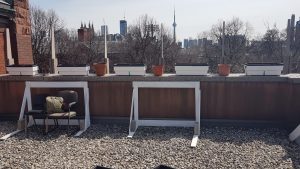
Hey there! I am gardening a container based rooftop vegetable garden in downtown Toronto. It is not protected from the wind which caused some problems last year –big storms did a lot of damage to the exposed plants. There is a 4 foot wall that surrounds the rectangular rooftop, running about 30 feet by 20 feet. My idea is to mount some containers to the top of this wall, and create a living & beautiful windbreak. In a perfect world, the plants selected would be tall or bushy, native, perennial, drought hearty, and if they flower in late summer that would be a bonus! I know this is narrowing list, and maybe the idea is crazy already, so I’m open to any advice or ideas or suggestions you might have about creating a windbreak.
For context, they would be in full sun, and I can fill the containers with whichever soil mix is most suitable. I included a photo of my idea.
Thank you so much for your time! I look forward to hearing from the masters.
Windbreaks will definitely keep your plants from drying out or getting damaged in harsh weather. Trellises or other latticed windbreaks are best because they have holes that will disrupt the flow of the wind, rather than stopping it completely. Solid windbreaks are more likely to be knocked down by high winds. You don’t want to completely eliminate wind flow but rather to decrease it. These would likely be best installed inside the wall or attached to your existing containers. Trellises used as windbreaks are also ideal for growing climbing plants such as beans and peas or flowering plants like sweet peas, roses or morning glories which will also attract pollinator insects.
Placing other containers directly on the wall could be dangerous as they could fall either way, especially during heavy winds.
Another solution for a windswept area is to grow wind-tolerant and low-maintenance plants that can survive harsh rooftop conditions, during both summer and winter. These might include taller wind-tolerant shrubs with strong stems and branches, and small leaves such as Peking cotoneaster (Cotoneaster acutifolia), juniper (Juniperus virginiana) and fragrant sumac (Rhus aromatica).
Also, be sure to use light weight potting soil and containers made of plastic, fibreglass or other lighter weight material. Your flat roof may not be built for heavy loads.
Toronto Master Gardeners have answered many similar questions on rooftop gardening that you might find helpful. Here is a link:
https://www.torontomastergardeners.ca/askagardener/balcony-garden-4/

